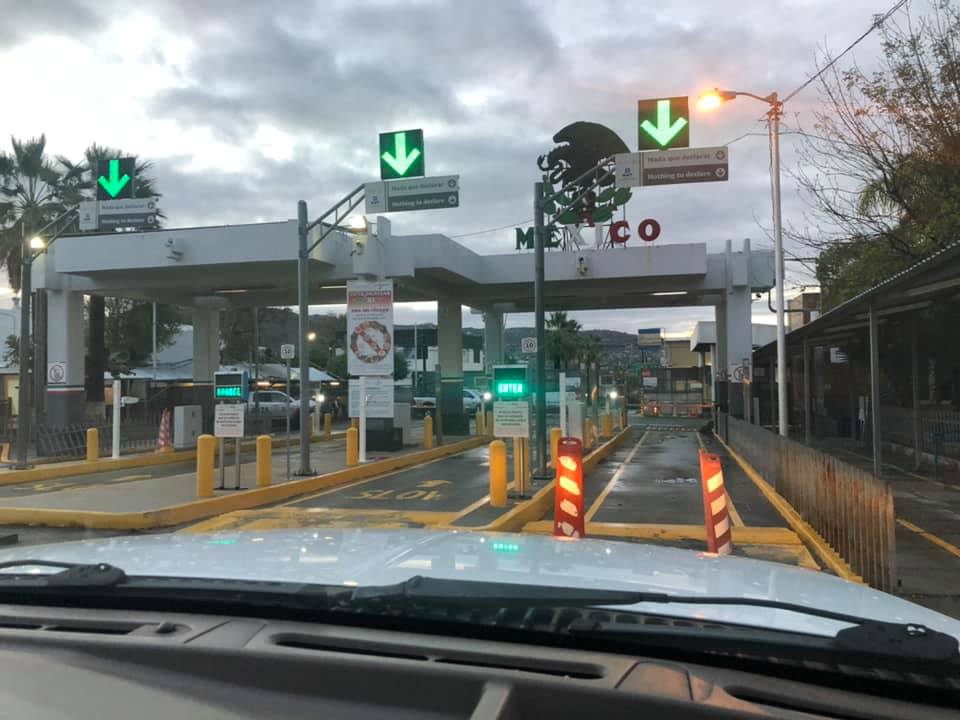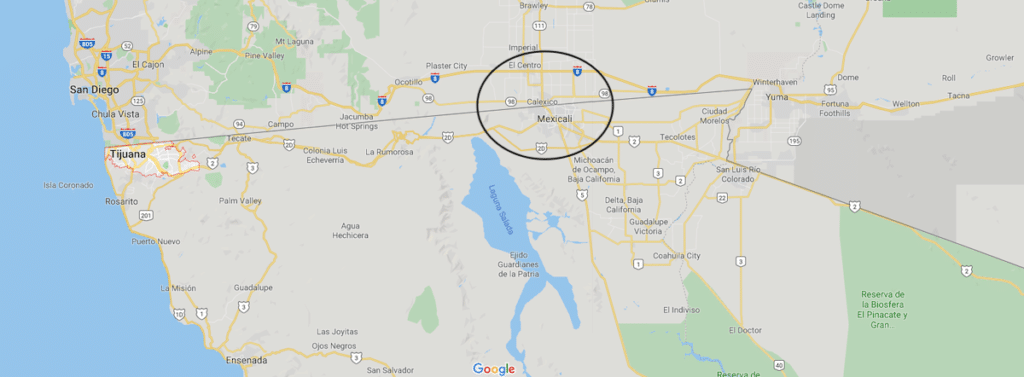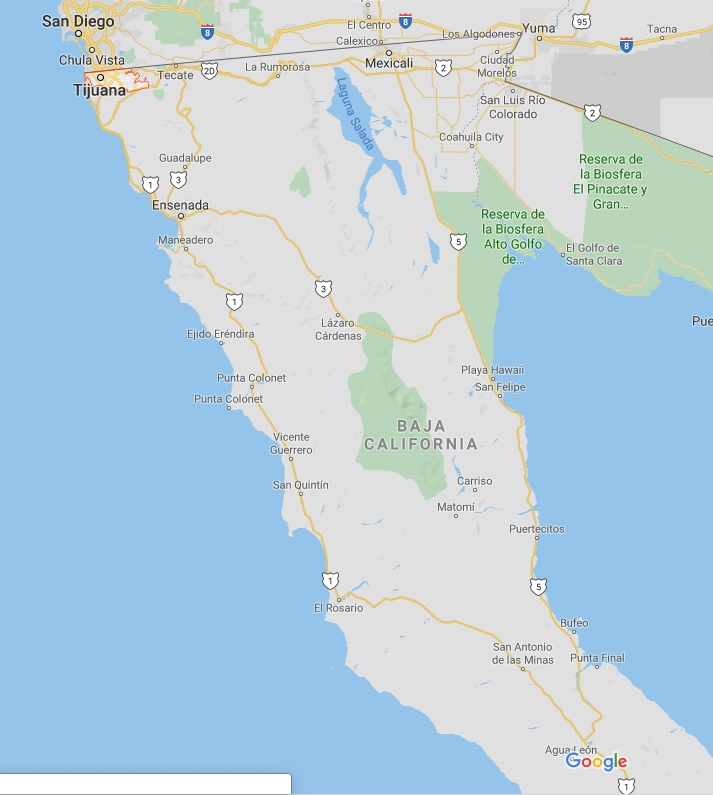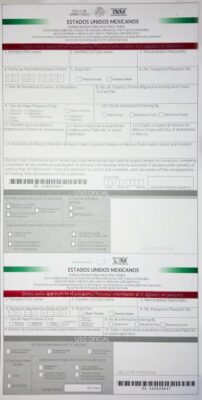Crossing the Border
In Part 1 of our series on Driving Baja, we discussed how to prepare for your road trip down the 1,000 mile long Baja peninsula. In this installment, we answer the most common questions about crossing the border.

Which Border Crossing is Best?
You’ve packed for your trip. You have all your documentation ready. (If not, see Part 1 of our Driving Baja series here.) Now, which border crossing should you choose? That depends on where your trip starts and what you are bringing with you. There are several border crossings, each with its own advantages.

Following are the border crossings located on the California/Baja California border. There are other border crossings further east, but those are further from the main highways that lead down the Baja peninsula, and not used as often so are not included here:
San Ysidro: This is the largest of the Baja border crossings and the busiest. It offers convenience, as it is close to San Diego hotels and is open 24×7. However, if it’s your first time crossing the border by car, San Ysidro’s size and route into busy Tijuana can make it an intimidating experience. Crossing at a smaller station can be less stressful, especially if you are bringing household goods with you.
Otay Mesa: This border crossing is just east of San Ysidro, yet still conveniently located less than a mile from the San Diego hotels on the US side. We have found this border station to be easier to navigate and quieter, especially early in the morning. If you are bringing any household goods or other items you need to declare, be aware that the inspector does not arrive until 8:00 a.m., so arriving any earlier than that won’t get you on your way any faster. (See below for what to determine what to declare.)
Tecate: A little further to the east is Tecate, a small town that also offers an easier crossing than San Ysidro. One drawback for travelers is its location: Tecate is not close to any major cities or hotels on the US side, so you’ll have to plan accordingly. The closest town is El Cajon, or you can stay a bit closer in Jacumba Hot Springs. Avoid the busier times, such as Friday nights, as there is only a single lane and traffic can quickly back up then.
Calexico/Mexicali: if you are coming from Arizona or further east, the Mexicali border station may offer the fastest crossing into Baja California. You can stay in Calexico on the US side of the border and cross the border first thing in the morning. From here, you will still need to drive west to MX-1, so check your route to see how far you can get from Calexico to make sure you’re at your destination before dark.

Should I Take Highway 5?
If you are crossing at Mexicali, you have the option to drive south on Highway 5, which goes through San Felipe and eventually connects with MX-1 further south. However, be aware there is a portion of Highway 5 that is still under construction, and the road gets very rough. A 4-wheel drive vehicle is recommended if you choose this route, and it’s generally not a good choice if you are towing a trailer or boat. Once this stretch of Highway 5 is paved (the government estimates it will be finished in February 2020), this route will provide an easier and more direct option to those coming from Arizona or further East.

When Should We Cross?
Typically the best time to use any of the border crossings above is early in the morning, when it’s still quiet and most of the border traffic is coming north from Mexico into the U.S. The San Diego and Calexico crossings have a number of hotels close to the border. It’s a good idea to plan your trip so you can stay at one of these hotels the night before, then cross the border early the next day. Tecate is perhaps the most remote border station; if you choose to cross there you will likely have to stay an hour or more away, so plan to get an early start.
What Documentation Do I Need?
You are traveling in a foreign country, so it’s best to be prepared with proper documentation, including the following:
A Valid Passport: You must have a valid passport to travel within Mexico, with an expiration date that is not set to expire within six months of your travel date. Gone are the days when you could travel with just a valid driver’s license from the US into Mexico. Prepare for your trip as you would for travel to any foreign country. Check with your country’s consulate and understand the tourist, immigration and visa requirements before you travel.
The FMM Tourist Permit: Other documentation required depends on whether you are entering the country as a tourist, a temporary or permanent resident, or as a Mexican citizen. If you are not a citizen, and have not yet obtained a temporary or permanent resident visa, you will need what is called an FMM, which stands for Forma Migratoria Múltiple, otherwise known as a tourist permit. You can obtain and fill out your FMM in advance online here, or you can fill it out in person at the Mexican Immigration (INM) office at the border, before you cross.
Other documentation required depends on whether you are entering the country as a tourist, a temporary or permanent resident, or as a Mexican citizen. If you are not a citizen, and have not yet obtained a temporary or permanent resident visa, you will need what is called an FMM, which stands for Forma Migratoria Múltiple, otherwise known as a tourist permit. You can obtain and fill out your FMM in advance online here, or you can fill it out in person at the Mexican Immigration (INM) office at the border, before you cross.
The FMM is your permission to travel temporarily as a foreigner within Mexico, and is legally required to enter Mexico. If you get into an accident and do not have your FMM permit, your insurance claim can be denied. As a tourist, you can also be deported at anytime for not having your FMM. If you are planning to leave the country by air, you will need to present your stamped form at the airport before the airline agent will issue your boarding pass.
Whether or not you fill your FMM tourist permit form out ahead of time, you are legally required to stop at the immigration office before you cross the border to have your permit stamped and to pay the fee. If you don’t stop to do this, you can be sent back to the border at any point along your drive to complete this step. There are no immigration offices along the drive down Baja where you can get this done, so you will have to return to the border if you forget.
The immigration office is usually on your right as you approach the border, before you cross. Look for a building called INM, or Instituto Nacional de Migración. Pull over here and park in the parking lot in front of the building. Enter the office with your pre-filled out form, or ask the agent at the desk for a form to fill out. Once you fill it out, the agent will stamp it and ask how long you plan to be in Mexico. You can stay in Mexico for up to 7 days for free if traveling by land, or pay a small fee for a longer stay of up to 180 days.
Note: You do not need to fill out the tourist permit (or pay a fee) if you already have a temporary or permanent resident visa.
Do I Need to Declare My Stuff?
There are separate lanes at the border crossings for those with Nothing to Declare and for those with items that need to be Declared. To declare or not to declare is a question much debated online in the various Baja Facebook groups. Ultimately, only you can decide which way you want to go, but here are some guidelines to help you:
- If you are traveling with basic belongings (your clothes in suitcases, etc.), and you are not carrying any items on the regulated list, it is probably fine to use the Nothing to Declare line.
- If you are bringing household goods (the back of your vehicle is packed full, you are pulling a trailer, etc.) then it’s likely you will need to fill out a basic form to list the items you are bringing with you into the country. An inspector will review your vehicle and may assess import fees that you must pay before being allowed to proceed. These can vary widely depending on where you cross, the inspector, the time of day, and the items in question.
- If you are clearly carrying new merchandise (especially anything still in its original packaging), you will need to go to a different area (the high value declare area) and show receipts for those items so they can declare the value of the items you are bringing and assess the import fees due. No receipts may mean they will calculate the value using other means.
What If I Have to Pay Import Fees?
If you are assessed import fees, you will need to go inside the customs area and pay the fees due. The cashier will give you a receipt, which you then give to the agent in the booth as you drive through the border gate. If you are assessed a higher value than you feel is warranted, you do have the right to contest it, but the burden will be on you to provide proof of alternative valuation.
After You Cross
You’ve just crossed into a new country, you’re not familiar with the area, and the signs are all in Spanish. The best way to proceed at this point is to drive slowly, obey all traffic signs and speed limits, and be courteous. Most issues occur as a result of an inadvertent moving violation. There may be local police watching, so take your time, drive carefully, and go slowly. If you do get stopped, be polite and patient and, if you truly didn’t do anything wrong, stand firm politely and the officer may let you go. If the officer insists you committed an infraction, ask that he write you a ticket.
Do not under any circumstances offer to pay cash on the spot, this is a bribe and it is illegal.
Politely and firmly insist on a ticket. In most cases, the officer will let you off with a warning and you’ll be on your way again shortly enough. If the officer does issue you a ticket, you can ask for directions to the nearest police station to pay it. All of that said, it is our experience that, as long as you drive carefully, pay attention to traffic signs and obey the driving laws, you will not be stopped.
You’re On Your Way!
Congratulations, you’ve successfully crossed into Baja California, Mexico! As you proceed, be sure to drive carefully and be aware of your surroundings, but also take your time and enjoy some of the most beautiful scenery you’ve ever seen.
In our next and final installment in our Driving Baja series we’ll talk about the different options for driving down the 1,000-mile long Baja peninsula, including 2-day and 3-day routes with popular stops along the way.
